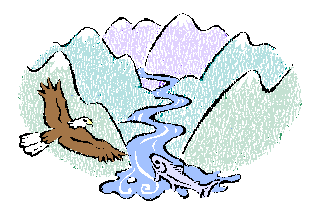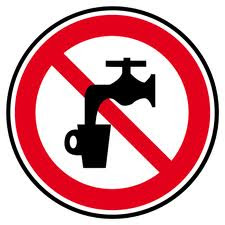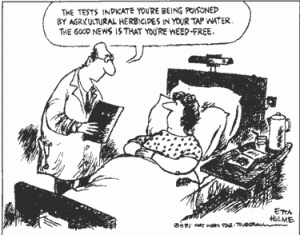The Pure Water Occasional for February 17, 2014
In this President’s Day Occasional, you’ll hear about Dick Armey, the National Pork Council, endocrine disruptors, and the world’s first cold water curtain. There’s news about the close relationship between water and potatoes, the dead zone, and the California drought. Then there are unknown and unregulated chemicals, sex change hormones, the evaporative power of the sun, and even the name of the oldest known koi. And, as always, there is much, much more.
The Pure Water Occasional is a project of Pure Water Products and the Pure Water Gazette.
Why Are We Siding with Polluters?
by Jennifer Heckler
Introductory Note: A couple of decades ago our U.S. Congressman became a regional hero by bravely protecting us from the Environmental Protection Agency. The EPA was determined to destroy the American way of life in our part of North Texas by imposing severe air quality standards. Locals cheered Representative Dick Armey’s bold defense of our right to breath polluted air, and he was repeatedly reelected until he retired. I never understood how seemingly sensible people can be so easily suckered into acting in their own worst interest. We are today breathing some of America’s worst air because of Mr. Armey’s tireless defense of our right to not let “them bureaucrats in Washington” push us around. Armey, of course, no longer lives here to breath the air. He’s breathing clean air in one of his mansions far removed from the south wind that blows Dallas’s scarcely regulated bad breath on us.
Jennifer Heckler’s interesting piece below shows that America’s tendency toward self-sacrificing stupidity is still alive and well. — Gene Franks
Last week, the state of Florida used your tax dollars to take legal action to try to stop the cleanup of the Chesapeake Bay in the mid-Atlantic region.
While dirty water abounds here at home, Florida Attorney General Pam Bondi filed a brief against the Bay cleanup plan — along with the polluters (the American Farm Bureau Federation, National Pork Council, The Fertilizer Institute, National Beef Cattleman’s Association, etc.).![]()
These are the same types of polluting industries we’ve been trying to get to capture and treat the pollution that they generate here in Florida. They are also the same polluting interests that joined Bondi in suing the U.S. Environmental Protection Agency to fight protective enforceable water quality standards for controlling fertilizer, sewage and agricultural runoff into Florida’s waters for drinking, swimming and fishing.
As both Florida’s waters and the Chesapeake are being polluted by nutrient pollution, having an effective nutrient pollution cleanup plan for the Chesapeake means Florida’s polluters could have to do more to treat their own pollution on-site, rather than disposing of it in our waterways. This would save us from having to pay more of the ever-increasing costs of declining tourism and real estate values, as well as for additional publicly funded cleanup projects.
We understand why the polluters would fight the cleanup of the Chesapeake, but we are confounded and outraged as to why our state would.
This cannot be credibly portrayed as a state’s-rights issue, as the Chesapeake Bay states signed and supported the cleanup plan. This also cannot be portrayed as protecting Floridians’ interests, as this is not in Florida and would set a negative precedent toward having effective cleanup plans for Florida’s waters.
Contact Florida Gov. Rick Scott (850-488-7146) and Attorney General Pam Bondi (850-414-3990), to tell them they need to stop and withdraw this dirty-water lawsuit immediately, using our tax dollars to clean up Florida’s polluted waters instead.
And to the people of the Chesapeake, we as Floridians apologize that our state leadership would try to prevent you from having a clean bay for you to safely enjoy.
Please know we want you to have clean water, just as much as we want it for ourselves.
Jennifer Hecker is director of natural resource policy for the Conservancy of Southwest Florida. Contact her at jenniferh@conservancy.org. For more information on the Conservancy of Southwest Florida, go to www.conservancy.org.
Source: Tallahassee.com
Pure Water Gazette Fair Use Statement
Endocrine Disruptors: Latest Threat to Surface Waters
By Cornelius B. Murphy, Jr.
The United States has one of the world’s best systems for both wastewater and potable water treatment and distribution; however, that doesn’t mean we are without challenges.
We are familiar with the impact of various synthetic organic chemicals on the human endocrine system and their ultimate stress on human reproduction, growth and/or development. The endocrine disruptors mimic or block hormones and disrupt the way the body normally works through the functional impairment of the endocrine glands: pituitary, thyroid, adrenal, thymus, pancreas, ovaries and testes. Each of the endocrine glands releases hormones that serve as messengers to various areas of the body to control essential functions.
Environmental-based endocrine disruptors, including some of the PCB arochlors, dioxin, DDT and other synthetic organic compounds that we might inhale, eat or otherwise have contact with, are seen as contaminants when they get into our water in undetermined amounts. These compounds mimic our body’s natural hormones, causing the body to overreact or react at inappropriate times.![]()
It is now recognized that humans can be exposed to endocrine disruptors through drinking water. Endocrine disruptors have been detected in both ground and surface water. Under the Safe Drinking Water Act, there is no requirement to analyze for the presence of endocrine-active chemicals such as bisphenol A, alkylphenols, ethinylestradiol and others in our treated drinking water. Likewise, there is no such requirement under the Clean Water Act to test for these chemicals in our wastewater.
In our surface waters, the most significant sources of endocrine-active chemicals most likely are the effluent from municipal wastewater treatment plants. Many estrogenically active compounds, such as estradiol and derivative compounds, are treated to levels of 80 percent or greater by secondary treatment of municipal wastewater. [1]
That still leaves significant concentrations of endocrine-active chemicals that are discharged to receiving waters via treated municipal wastewater. These and other sources of these compounds have significant impacts on the aquatic system including, but not limited to, reproductive impacts on fish populations and invertebrates.
Municipal wastewater is clearly not the only source of endocrine-active chemicals. Hormones are introduced into livestock feed to increase meat production. Significant amounts of these growth hormones end up in surface water systems from storm water that flows across agricultural land.
We need to be concerned that our potable water might be contaminated at low levels by medications, antibiotics and hormones that we take in hopes of improving our health, and by hormones used in agriculture.
It is vital that we better understand the concentrations of these contaminants in our municipal, industrial, and agricultural wastewaters and storm water. We need clearer information about the concentration and distribution of these endocrine-active chemicals in our surface and ground waters. More resources need to be dedicated to monitoring our receiving waters, wastewater, storm water and drinking water.
We need to implement the recommendations of the Endocrine Disruptor Screening and Testing Advisory Committee and develop a strategy to mitigate the risk to human health and the environment. The U.S. Environmental Protection Agency has received $131,514,000 since 1999 to screen nearly 89,000 synthetic organic chemicals for endocrine disruption activity. [2] This represents only a beginning in our attempt to understand this issue and its impact on human health and the health of our biosphere. This pervasive human health problem deserves more attention.
References:
1. Ternes TA, Stumpf M, Mueller K, Haberer K, Wilken R-D, Servos M: Behavior and occurrence of estrogens in municipal sewage treatment plants — I. Investigations in Germany, Canada and Brazil” Sci Total Environ 1999, 225: 81-90
2. Reference: Minn Post “Endocrine disruptors in water: Minnesota is ahead of Wis. in testing” 4/22/13, page 4 of 7
Water News
The ongoing flooding in Great Britain, the California drought, and the Charleston licorice-water debacle dominated water news this week, but there was a lot more as well:
BP Deepwater Horizon spill oil causes heart damage that can kill tuna, new study finds. Crude oil from the BP Deepwater Horizon spill contains a chemical that interferes with fish heart cells, slowing heart rates, reducing the ability of the heart to contract and causing irregular heartbeats that can lead to heart attacks or death, according to new research.
World-first cold water curtain getting closer to completion. It’s a world first and includes products from all parts of the globe put together with Australian know how and technology. Burrendong Dam’s huge cold water pollution curtain will be complete in almost three weeks, one of three projects happening across the giant dam.
Irrigation boosts potatoes, but Minnesota town pays more for water. A growing awareness about Minnesota’s groundwater challenges is about to hit the residents of Park Rapids in the wallet.
14 reservoirs in Southern California near record lows. Less than 1 percent of the capacity of the 14 dams spread across Los Angeles County is available for release, according to data from the Department of Public Works.
Convicted sewage dumper loses another court challenge. A federal judge in Detroit has rejected a challenge to a former landlord’s conviction for illegally dumping an estimated 107,000 gallons of raw sewage into Southeast Michigan’s Huron River.
California farms are slow to adopt water-saving technology. For more than four decades official reports have cautioned that California could suffer long droughts and that population growth was outstripping storage capacity. Yet despite repeated warnings, many California farming communities are ill-prepared for a parched future that seems to have arrived.
New Louisiana plan relies heavily on diversions to reduce nutrients causing Gulf ‘dead zone.’ Louisiana plans to use existing and proposed sediment and freshwater diversions as part of a new plan for removing a small share of the fertilizers from the Mississippi and Atchafalaya rivers that are linked to “dead zones.”
New York City tries to rid its sewers of fog (fat, oil and grease). Out of sight of most New Yorkers is a sprawling underground labyrinth of about 7,500 miles of sewers, part of the city’s vast and, in many cases, aging subterranean infrastructure. Besides old age, the sewers are under assault from a nemesis above ground: grease.
Broken sewer main leaks 100,000 gallons into California river. A ruptured sewer main in Guerneville spewed an estimated 100,000 gallons of raw sewage into the Russian River on Thursday before crews could stop the leak and begin repairing the pipe. Drinking water supplies were not threatened and sewer services weren’t affected.
Are Water Treatment Dealers Being Too Nice?
by Gene Franks
“Most of the time no one is testing most of the water for most of the chemicals.”
In the wake of the West Virginia chemical leak and subsequent drinking water crisis, a company that markets its advertising services to water treatment professionals put out a statement that says, in part:
No water dealership should ever use scare tactics as a marketing strategy.
In Pinellas County, FL, the municipality actually cautions homeowners in their markets to be aware of companies who . . . try to scare consumers under the guise of public awareness. In Minnesota, the Department of Health is warning homeowners to beware of companies using bottle drops accompanied with misleading and frightening statistics about the local water quality. Our own industry organization, The Water Quality Association, also takes a hard stance against scare tactics in the WQA Code of Ethics.
But every time another instance of water contamination occurs, it reaffirms people’s concerns with their water. They worry about the levels of prescription drugs and fertilizer run-off in their water and how it might affect their families. They worry about the taste and smell of their water. They worry about studies in the news equating levels of lead [and] arsenic with their children’s development.
Fear has always been a key feature of American marketing. Whether the product being sold is a physical object or a political slogan, fear always gets people’s attention.
Most of us in the water treatment business don’t descend to the tactic mentioned above — using “drops” (a precipitation test) to create visions of bogus deadly contaminants –but we are way too polite, I think, when it comes to talking about genuine health issues involving water.![]()
Many conventional “dealerships” embrace a code of ethics which focuses attention on aesthetic issues (as the marketing company statement suggests) and speak not a word about the hard health-related issues. This means portraying the failure of soap to lather as a life-and-death dilemma while failing to mention the (literally!) 100,000 or so unregulated, un-tested chemicals that are being sprayed on lawns, peed into toilets, and leaked into reservoirs from rusted-out tanks. Since talking about bladder cancer might be viewed as impolite or politically incorrect, we stick to the real issues, like spot-free dishes.
I have always been a strong supporter of municipal water systems. I’m truly impressed by the job they do. Every day, our local water company takes millions of gallons of grim-looking lake water and turns it into clear, mainly pathogen-free liquid that is wonderful for watering lawns, washing cars. flushing toilets, and washing dishes. The water company also carries out periodic testing, as mandated by law, of a short list of items that are regulated by the Environmental Protection Agency. If their water exceeds standards in any of the EPA’s regulated contaminants–like Lindane or chloroform or lead–they are required to notify us. What we aren’t often told, though, is that there are thousands upon thousands of known but unregulated chemicals, plus certainly thousands of unknown chemicals, that are not being regulated by the EPA or tested for by the water company or by anyone else. By “unknown chemicals,” I mean compounds that haven’t yet been discovered. As a single example, we had been using chlorinated water for decades before the spin-off byproducts of chlorination that are now regulated by the EPA were discovered.
These chemicals should be a concern, and I think we should be worried about them. Worried enough to tell our customers that there is a real danger from chemicals that no one has heard of or no one is testing for coming into our homes.
It is naive to believe that the recent West Virginia chemical incident is unique or to be reassured because the water company eventually turned off the water. In reality, the water provider “discovered” the obscure chemical not because they were testing for it but because it had a strong, odor and because their customers smelled it and called in complaints. Had the chemical been colorless, odorless, and tasteless, it would certainly have gone unreported and unnoticed unless it caused immediate and severe symptoms in water users.
It would be equally naive to not suspect that chemical and biological contaminants go unnoticed in public water systems with a fair degree of regularity. It has been suggested, for example, that much of what is assumed to be food poisoning is often mild sickness caused by water contamination. Highly publicized cases show that military bases have delivered chemically contaminated water to soldiers and their families over a decade or more before the situation was brought to light.
A fact about public water supplies that should not be forgotten is one that I read over thirty years ago: “Most of the time no one is testing most of the water for most of the contaminants.”
I think that instead of fretting so much about saving laundry soap we should be talking about protecting ourselves from chemicals and microbes, not because we are nervous nellies but because we are practical people. We put locks on our doors and circuit breakers on our electrical boxes to protect against the unexpected. We should also have carbon filters as a barrier against chemicals, known and unknown, plus a superb drinking water system like reverse osmosis, the most comprehensive in-home protection against water contaminants. And as infrastructure ages and the pipes that carry water to our homes lose their integrity, we should be more concerned about microbes as well, making ultraviolet a sensible addition even to homes receiving municipal water.
As a vendor of water treatment equipment, I don’t plan to start scaring people with bogus tests, but I am going to start being more forthcoming with information about the real dangers we face in our chemical-laden world.
Drugs in Water. Where They Come From.
Below is a cut from the April 11, 2010 issue of Dr. William Campbell Douglas’s popular online newsletter. In it Dr. Douglas reiterates the information released earlier that month about the severe pharmaceuticals contamination of water by the public use of medicated bath products. I would point out that this is an extreme statement of the issue, and I, personally, would much rather have a drink of American tap water than “suck up a mud puddle in a Third World country.” His point is well taken, though, and in the four years since the article first appeared in the Occasional there have been countless new reports about the growing problem of contamination by pharmaceuticals and personal grooming and health-care products.–Hardly Waite.
How creams and lotions contribute to water pollution
If you’re slathering on topical creams, antibiotic ointments, medicated patches and hormone lotions, you’re not just marinating yourself in unnecessary meds — you’re sharing them with your friends and neighbors as well.
An alarming new study presented at the American Chemical Society’s annual meeting shows that when you bathe, these drugs head right into the water table, where they make a beeline for taps all over town.
Thanks, pal. Just what the rest of us a need — an extra dose of YOUR meds.
But hey, it’s not just you. We’re all drinking each other’s drugs. Every prescription pill you swallow eventually comes out the other end, where it gets flushed down the drain. That’s bad enough — but at least those meds are diluted by their trip through the body.
All those creamy, gooey lotions, on the other hand, are still full-strength drugs when you wash them off.
And forget water treatment plants — trusting them to keep chemicals out of your tap water would be like trusting the French to keep out the Germans.
I’ve been warning of tainted water for years. Every day, millions of Americans are exposed to some of the worst drugs, chemicals and toxins imaginable — all pouring out of your supposedly safe tap water.
Everything from sex-change hormones to rocket fuel has been found in U.S. drinking water from coast to coast — in big cities and small towns alike. Some of these poisons enter as human waste, like those drugs I just mentioned… but others are a byproduct of corporate greed as American industry uses your waterways as its own private dumping grounds.
And of course, plenty of other toxic additives are put in on purpose — fluoride, chlorine and a few extras they haven’t copped to yet. Feminizing, sissy-making hormone drugs keep turning up in our water, making men impotent and weak — and I refuse to believe it’s an accident.
Add it all up, and we’ve got some of the world’s most polluted water — and there’s little you can do to protect yourself from it. Don’t waste your money with supermarket water filters — get yourself a reverse-osmosis filter and install where the water enters your home.
And if you want the shocking truth about what tainted water can do to a community… keep reading!
Tainted water leads to cancer spike
I’ve been warning you for years about tainted water — and now, one community is paying the ultimate price.
A cancer cluster has been uncovered in the Chicago suburb of Crestwood… where residents were unwittingly drinking contaminated water for decades.
The Illinois Department of Public Health says this small village of 11,000 people is suffering from elevated rates of gastrointestinal, kidney, lung and colorectal cancers. And while you can lead a bureaucrat to tainted water, you can’t make him think — because the report actually stops short of blaming the water itself.
But everyone knows what really happened in Crestwood.
The contamination was first exposed in 1985, when state EPA tests found traces of a chemical used in dry cleaning in the local well water. They alerted the village, which said it would stop using the dirty water.
That’s when this story gets really, truly frightening… because the village then inexplicably continued to use this undrinkably bad sludgewater for 20 more years. Even worse: They stopped testing it!
That’s right — not a single follow-up test over 20 years. And if that’s the case in a place like Crestwood, where they KNEW the water was contaminated, what chance does your town have?
Answer: None.
This toxic tale tells you everything you need to know about the inability of public officials to test and regulate the water supply.
It’s sad — but expect to hear about more Crestwoods. Water contamination is the next big crisis ready to explode, and your town may be next. Truth is, you’re better off sucking up a mud puddle in a Third World country than sipping a glass of typical American H20.

Gazette Numerical Wizard Bee Sharper Indexes the Numbers that Harper’s Misses
Numerical water facts from B. Sharper, the Pure Water Gazette’s numerical wizard.
Age of Hanako, the oldest known koi, when the fish died in 1977: 226.
Amount of fracking water required for horizontal fracking: . 5,000,000 gallons.
Number of gallons of tap water required to equal the mineral content of one glass of orange juice: 30+.
Tons of water that the sun evaporates each day: 1,000,000,000,000 (one trillion).
Percentage of the Earth’s water that is salty and undrinkable: 97%.
Percentage of the Earth’s fresh water supply that is in Antarctica: 90%.
Percentage of US fresh water that is used for irrigation of crops or for generating thermo-electric power: 80%.
Percentage by which frozen water is lighter than liquid water: 9%.
Percentage of a chicken that is water: 75%.
Percentage of home water that is used in the bathroom: 66%.
Number of separate water contaminants that have been identified: 70,000 +.
.
Please visit our RO Parts Page for tanks and accessories.
Thank you for reading. Please come back next week.
Places to Visit on Our Websites in the meantime
Model 77: “The World’s Greatest $77 Water Filter”
”Sprite Shower Filters: You’ll Sing Better!”
An Alphabetical Index to Water Treatment Products
Our famous whole house Chloramine Catcher
Pure Water Occasional Archive: Sept. 2009-April 2013.
Write to the Gazette or the Occasional: pwp@purewaterproducts.com
Please Visit
The Pure Water Gazette – now in an easier to navigate format.
![occasionalbanner300[1]](https://ymlp.com/https.php?id=purewatergazette.net/blog/wp-content/uploads/2013/04/occasionalbanner3001.gif)





